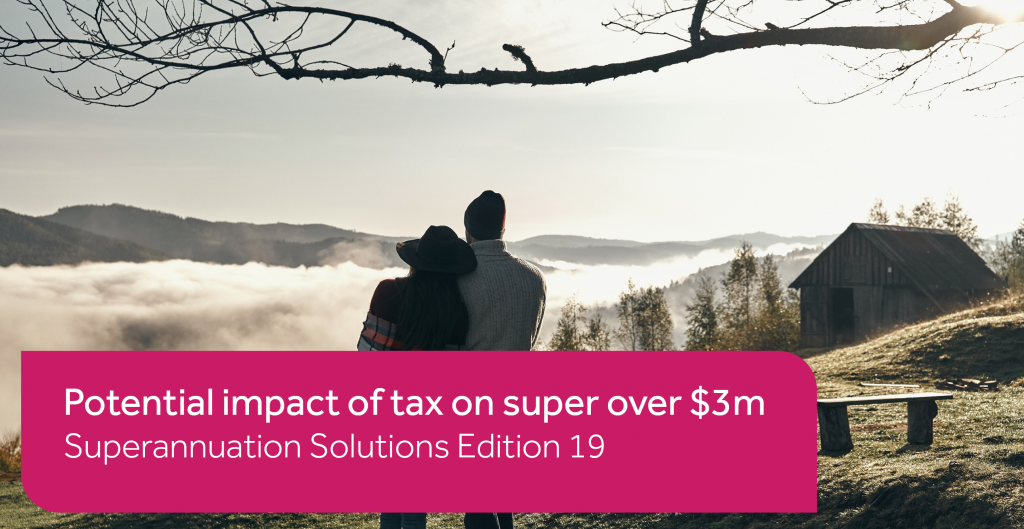In Superannuation Newsletter 17 we reported on the proposal by the Federal Government to introduce an additional 15% tax on a proportion of the super “earnings” of a member where the member’s total super balance is greater than $3m at the end of a financial year. The new tax is intended to be first levied in the 2025-26 financial year.
Research on the potential impact of the new tax
At the request of the SMSF Association, the International Centre for Financial Services at the University of Adelaide has researched the wider aspects of the potential effect of the proposed new tax on super fund members.
The research involved analysing the data of over 720,000 SMSF members by “backtesting” the proposed changes against data from 2021 and 2022. This represents more than 67% of the total number of SMSF members. The data was extracted from the databases of three major SMSF platforms – Class, BGL and Super Concepts – after any information that would identify the fund or members had been removed.
The tests were run on both an “unbalanced panel” of members and a “balanced panel” of members. An unbalanced panel comprises all the members in the data, irrespective of whether they appeared in just one, or both years. As a result, the unbalanced panel is sensitive to new account openings and account closures. A balanced panel comprises only those individuals who were SMSF members in both 2021 and 2022.
How many SMSF members will be affected by the new tax?
By taking the proportion of members in the balanced panel who would have been affected by the new tax in 2021 or 2022 and multiplying this by the total number of SMSF members nationally, the research indicates that a minimum of 44,000 to 50,000 SMSF members would be affected. This is likely to be a low estimate, as members may have super assets outside their SMSFs which cannot be taken into account in the testing, and the value of super assets can be expected to increase between 2022 and 2026 when the new tax will come into effect.
Distribution of estimated tax liabilities
Not surprisingly, the revenue estimates and distributions were affected by the wider economic climate, with 2021 being widely a bull capital market and 2022 being largely a bear capital market. The research indicated that the total estimated revenue that would have been raised by the new tax in 2021 is $2.78 billion, but only $1.14 billion in 2022.
One significant finding is that the distribution of the tax liability across individual members is highly skewed towards those with the highest total super balances. In 2021 the average tax liability was $89,000 but the median (middle score) was only $28,000. In 2022 the average tax liability was $83,000 but the median was only $9,000. In fact, the top 1% of affected members would have contributed 27% of total revenue in 2021 and almost 60% in 2022.
This may have significant political implications for the Federal Government in selling the new tax to the electorate. Instead of dealing with the very important equity issues such as the taxation of unrealised gains, the tax will probably be characterised for political purposes as something that need not concern the average Australian, but will only affect the “very rich”. In terms of the economic trade-off between providing tax concessions to super funds on the one hand and saving on payments of the age pension on the other, the Federal Government probably sees the new tax as a gain with little chance of loss, as the members targeted by the tax are extremely unlikely to ever qualify for the age pension.
Fund liquidity and payment of the tax
The new tax is designed to be imposed on the member, with the option of arranging for the fund to pay the tax. The researchers had no data on the ability of members to pay the tax from their own financial resources, but did examine how fund liquidity stacked up against the potential tax liability.
Based on the unbalanced panel and considering each of 2021 and 2022 independently, the research indicated that between 3% (in 2022) and 11% (in 2021) of all SMSFs would find it difficult to cover payment of the new tax from their own liquid assets. This represented members with an estimated tax liability of greater than the fund cash balance plus $5,000.
Using the balanced panel, the researchers were able to estimate the number of members who would experience cash flow problems if their fund had to pay the 2021 and then in addition the 2022 tax. In this situation there was a four-fold increase in the 2022 rate of liquidity problems, from 3.1% to 13.5%. Again, it is not at all surprising that the basic design flaw of taxing unrealised gains should give rise to liquidity problems.
Clearly, there are major issues still to be resolved in relation to the government’s proposed new tax on super balances.
Please contact your Nexia Edwards Marshall NT advisor if you would like to discuss any aspect of the proposed new tax.


